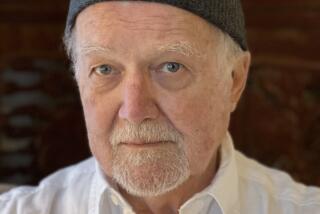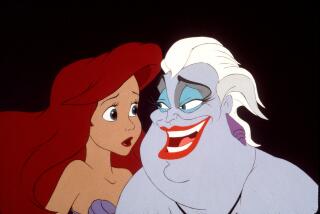Is ‘Saving Mr. Banks’ too hard on ‘Mary Poppins’ creator?
- Share via
In the winter of 1933, in a thatched cottage in Sussex, England, a complicated woman named Pamela “P.L.” Travers began to write “Mary Poppins,” the first in a series of novels that would inspire the beloved 1964 Walt Disney movie and supply generations of children with a magical fantasy nanny.
The reality of Travers’ own turbulent childhood — and her reluctance as an adult to relinquish control over her characters to Walt Disney — are the subject of the movie “Saving Mr. Banks,” which has just gone into wide release. Directed by John Lee Hancock, “Saving Mr. Banks” follows Travers (Emma Thompson) as she travels to the Disney lot in Burbank for two weeks in 1961, tangling with and tormenting the studio chief (Tom Hanks). The L.A. visit inspires Travers to recall her childhood in Australia, in particular her father, a charismatic drunk played by Colin Farrell.
Some critics have complained that “Saving Mr. Banks,” which Disney itself produced and distributed, is too hard on Travers and too easy on the company’s founder. Travers is cold, critical and strange — arbitrarily objecting, for instance, to having the color red in the movie and dismissing Disney’s “silly cartoons.” “Uncle Walt,” by contrast, is jovial and encouraging, with few flaws to speak of save for a bad smoker’s cough.
VIDEO: ‘Saving Mr. Banks’: Watch cast, crew discuss the film
Almost all of what appears in “Saving Mr. Banks” is true. Travers really did hector and frustrate the people at Disney, a fact substantiated by 39 hours of audio recordings of the author’s sessions with “Mary Poppins” screenwriter Don DaGradi, who is played here by Bradley Whitford, and songwriter brothers Richard Sherman (Jason Schwartzman) and Robert Sherman (B.J. Novak).
But the makers of “Saving Mr. Banks” admit they took some liberties with Travers’ often tragic life story — they say they actually added a spoonful of sugar.
“[Travers] was an incredibly difficult person and actually much more difficult than she’s portrayed in the film,” said Kelly Marcel, who shares screenplay credit on the movie with Sue Smith. “But the more I found out about her childhood, the more I felt for her. A lot of children’s authors create these characters from places of tragedy and darkness. I felt it was a beautiful story even though she was an absolute pain.”
Australian producer Ian Collie, who made a documentary about Travers in 2002, hatched the idea for a biopic about her, eventually involving independent producers in Britain, a path to the screen that was initially free of Disney input.
PHOTOS: Best films of 2013 | Betsy Sharkey
“This was a script completely developed outside of Disney,” Hancock said. “It would have been difficult for this script to happen inside the studio walls.”
Smith, an Australian writer, penned the first draft of the screenplay, which focused on Travers’ strange single-motherhood tale; in real life, the creator of one of fiction’s most beloved caregivers had promised to adopt twin boys, and at the last minute decided to raise only one, never telling him about his brother. (Travers’ son, Camillus, died in 2011, having eventually met his twin brother as an adult in a bar.)
When Marcel came onto the project, she decided to leave out Camillus and split the script instead into a dual narrative, with one thread focused on Travers’ childhood, the other on two weeks of her decades-long feud with Disney. She also introduced a fictional character, an optimistic driver played by Paul Giamatti, with whom Travers finally shares a human moment.
“I felt we didn’t have a bridge to her feelings,” Marcel said. “We need someone to like her.”
Marcel’s script earned a spot on the Black List, a list of hot, unproduced screenplays circulating in Hollywood, which attracted the attention of executives at Disney — in reality the only studio that could have made a movie so laden with Disney intellectual property.
PHOTOS: Best films of 2013 | Kenneth Turan
“Once Disney bought the script, my big fear was, they’re going to try and sanitize Walt,” Marcel said. “There are going to be so many rules and stipulations, they’re going to say he can’t smoke, he can’t drink. And then they didn’t.”
Instead Marcel got access to Disney’s vast archive, including the 39 hours of tapes, which Travers had demanded be made, and to Richard Sherman, who consulted on the movie.
Sherman recalls Travers as frustrating and unkind. “The first thing [Travers] said to us was, ‘This is not going to be a musical,’ ” Sherman said, remembering the weeks he spent with Travers in 1961. “[“Saving Mr. Banks”] feels so real to me, it knots my stomach.”
Marcel said one change the studio asked her to make to the movie, which is rated PG-13, was to remove a swear word. Disney is also not shown smoking but does stub out a cigarette in one scene.
Disney — the man and his creations — have been the subject of interest in multiple media lately, including a critical opera by Philip Glass called “The Perfect American” and a dark independent movie shot surreptitiously at Disney World, “Escape From Tomorrow.”
According to Hanks, the fact that “Saving Mr. Banks” is really about Travers, and only spent a narrow time frame on Disney, absolved it of having to deal with some of the more unsavory parts of Disney’s history, such as his role in Hollywood labor issues in the 1940s and his relationships with some well-known anti-Semites.
“It was very prescribed what the screenplay was going to be,” Hanks said. “Everybody asks about the strike and the anti-Semitism. But by 1961 it was far enough in the past. He was at the studio and he was — I don’t want to say that he was beloved, but Walt was beloved.”
Reviews for the film have mainly been more positive than negative, and Thompson has earned Golden Globe and Screen Actors Guild nominations for her performance. But some critics have objected to what they consider a pro-Walt slant in a movie coming from the man’s own studio. LA Weekly’s Amy Nicholson wrote, “There’s something sour in a movie that roots against a woman who asserted her artistic control.”
PHOTOS: Box office top 10 of 2013
Marcel said she’s surprised by the critique. “I think I’m incredibly sympathetic toward [Travers] in this film,” Marcel said. “I don’t understand those reviews, but she’s a tricky character.”
Disney never invited Travers to the “Mary Poppins” premiere, but she came anyway, afterward telling Disney they had “lots of work to do” to ready the film for release (Disney dismissed her). Privately she told friends she found the film too saccharine.
“Kelly Marcel’s script poses a great what if,” Hancock said. “We know Travers didn’t care for the [“Mary Poppins”] movie. We know she wasn’t invited to the premiere. We know she didn’t care for the animation. We do know she cried at the premiere and nobody knows why. Kelly took that as an opportunity for a what if: What if these two weeks were a cathartic experience?”
Travers spent her later years writing other novels, poetry and nonfiction (none as commercially successful as “Mary Poppins”) and pursuing an interest in various spiritual ideas, including the teachings of the mystic George Gurdjieff and Zen mysticism, before dying in London in 1996.
Valerie Lawson, author of the Travers biography “Mary Poppins, She Wrote,” who has seen “Saving Mr. Banks,” defends its portrait of a difficult woman.
“Travers was prickly, but she had good reason to be unhappy as she went through many private struggles and, in many ways, was a woman who could rely only on herself,” Lawson said. “She tried to keep her private life very private so it would have been very confronting for her to see, or even think of herself as a film character. Then again, if she was alive, I can’t see how the film could have been made at all.”
More to Read
Only good movies
Get the Indie Focus newsletter, Mark Olsen's weekly guide to the world of cinema.
You may occasionally receive promotional content from the Los Angeles Times.










